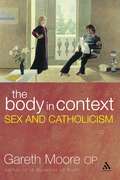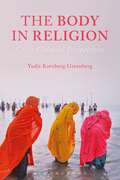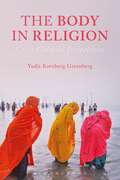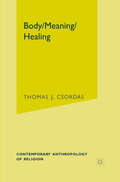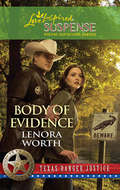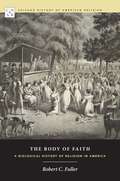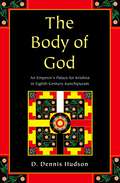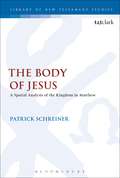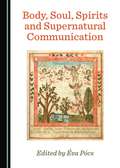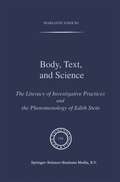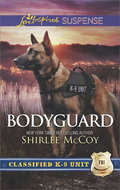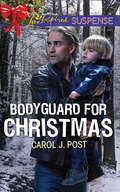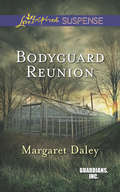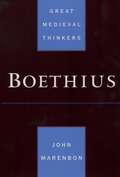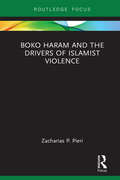- Table View
- List View
The Body in Context: Sex and Catholicism
by Gareth MooreIn this highly readable book Gareth moore examines some of the principle arguments and styles of argument advanced by Christians, particularly the Roman Catholic Church, in support of Christian standards in sexual ethics.Catholic teaching has sought to present those standards and values as ones which anyone can embrace; ones which they should be able to see as right if only they think about them in the right way. Arguments have been drawn from Scripture and also from philosophy and experience, the latter being particularly important at a time when the Church can no longer 'lay down the law', but has to be able to persuade.But are these arguments valid, or are they flawed? Moore's study covers such wide-ranging topics as sexual pleasure, the purpose of sex, sexual gestures, marriage, contraception and homosexuality; and in these areas, and the more specific sexual issues he covers, he often finds the Church's case to be defective. Though the Church has valuable things to say, its supporting arguments can be unconvincing. Better arguments, he claims, are needed; or, alternatively, the possibility has to be faced that the Churches' teaching needs modification. Whatever the case, the Church needs to do more thinking about sex.
The Body in Religion: Cross-Cultural Perspectives
by Yudit Kornberg GreenbergThe Body in Religion: Cross-Cultural Perspectives surveys influential ways in which the body is imagined and deployed in religious practices and beliefs across the globe. Filling the gap for an up-to-date and comparative approach to theories and practices of the body in religion, this book explores the cultural influences on embodiment and their implications for religious institutions and spirituality. Examples are drawn from religions such as Jainism, Confucianism, Daoism, Shintoism, Paganism, Aboriginal, African, and Native American religions, in addition to the five major religions of the world. Topics covered include: - Gender and sexuality- Female modesty and dress codes- Circumcision and menstruation rituals - God language and erotic desire- Death, dying, and burial rites - Disciplining the body through prayer, yoga, and meditation - Feasting and fasting rituals Illustrated throughout with over 60 images, The Body in Religion is designed for course use in religious studies as well as interdisciplinary courses across the humanities and the social sciences. Further online resources include a sample syllabus.
The Body in Religion: Cross-Cultural Perspectives
by Yudit Kornberg GreenbergThe Body in Religion: Cross-Cultural Perspectives surveys influential ways in which the body is imagined and deployed in religious practices and beliefs across the globe. Filling the gap for an up-to-date and comparative approach to theories and practices of the body in religion, this book explores the cultural influences on embodiment and their implications for religious institutions and spirituality. Examples are drawn from religions such as Jainism, Confucianism, Daoism, Shintoism, Paganism, Aboriginal, African, and Native American religions, in addition to the five major religions of the world. Topics covered include: - Gender and sexuality- Female modesty and dress codes- Circumcision and menstruation rituals - God language and erotic desire- Death, dying, and burial rites - Disciplining the body through prayer, yoga, and meditation - Feasting and fasting rituals Illustrated throughout with over 60 images, The Body in Religion is designed for course use in religious studies as well as interdisciplinary courses across the humanities and the social sciences. Further online resources include a sample syllabus.
Body, Meaning, Healing (Contemporary Anthropology of Religion)
by T. CsordasExactly where is the common ground between religion and medicine in phenomena described as 'religious healing?' In what sense is the human body a cultural phenomenon and not merely a biological entity? Drawing on over twenty years of research on topics ranging from Navajo and Catholic Charismatic ritual healing to the cultural and religious implications of virtual reality in biomedical technology, Body, Meaning, Healing sensitively examines these questions about human experience and the meaning of being human. In recognizing the way that the meaningfulness of our existence as bodily beings is sometimes created in the encounter between suffering and the sacred, these penetrating ethnographic studies elaborate an experimental understanding of the therapeutic process, and trace the outlines of a cultural phenomenology grounded in embodiment.
Body of Evidence (Texas Ranger Justice #2)
by Lenora WorthWhen Texas Ranger Anderson Michaels goes undercover at an animal rescue farm in Texas Hill Country, he lands right in owner Jennifer Rodgers's path.
The Body of Faith: A Biological History of Religion in America (Chicago History of American Religion)
by Robert C. FullerThe postmodern view that human experience is constructed by language and culture has informed historical narratives for decades. Yet newly emerging information about the biological body now makes it possible to supplement traditional scholarly models with insights about the bodily sources of human thought and experience. The Body of Faith is the first account of American religious history to highlight the biological body. Robert C. Fuller brings a crucial new perspective to the study of American religion, showing that knowledge about the biological body deeply enriches how we explain dramatic episodes in American religious life. Fuller shows that the body’s genetically evolved systems—pain responses, sexual passion, and emotions like shame and fear—have persistently shaped the ways that Americans forge relationships with nature, to society, and to God. The first new work to appear in the Chicago History of American Religion series in decades, The Body of Faith offers a truly interdisciplinary framework for explaining the richness, diversity, and endless creativity of American religious life.
The Body of Faith: A Biological History of Religion in America (Chicago History of American Religion)
by Robert C. FullerThe postmodern view that human experience is constructed by language and culture has informed historical narratives for decades. Yet newly emerging information about the biological body now makes it possible to supplement traditional scholarly models with insights about the bodily sources of human thought and experience. The Body of Faith is the first account of American religious history to highlight the biological body. Robert C. Fuller brings a crucial new perspective to the study of American religion, showing that knowledge about the biological body deeply enriches how we explain dramatic episodes in American religious life. Fuller shows that the body’s genetically evolved systems—pain responses, sexual passion, and emotions like shame and fear—have persistently shaped the ways that Americans forge relationships with nature, to society, and to God. The first new work to appear in the Chicago History of American Religion series in decades, The Body of Faith offers a truly interdisciplinary framework for explaining the richness, diversity, and endless creativity of American religious life.
The Body of Faith: A Biological History of Religion in America (Chicago History of American Religion)
by Robert C. FullerThe postmodern view that human experience is constructed by language and culture has informed historical narratives for decades. Yet newly emerging information about the biological body now makes it possible to supplement traditional scholarly models with insights about the bodily sources of human thought and experience. The Body of Faith is the first account of American religious history to highlight the biological body. Robert C. Fuller brings a crucial new perspective to the study of American religion, showing that knowledge about the biological body deeply enriches how we explain dramatic episodes in American religious life. Fuller shows that the body’s genetically evolved systems—pain responses, sexual passion, and emotions like shame and fear—have persistently shaped the ways that Americans forge relationships with nature, to society, and to God. The first new work to appear in the Chicago History of American Religion series in decades, The Body of Faith offers a truly interdisciplinary framework for explaining the richness, diversity, and endless creativity of American religious life.
The Body of Faith: A Biological History of Religion in America (Chicago History of American Religion)
by Robert C. FullerThe postmodern view that human experience is constructed by language and culture has informed historical narratives for decades. Yet newly emerging information about the biological body now makes it possible to supplement traditional scholarly models with insights about the bodily sources of human thought and experience. The Body of Faith is the first account of American religious history to highlight the biological body. Robert C. Fuller brings a crucial new perspective to the study of American religion, showing that knowledge about the biological body deeply enriches how we explain dramatic episodes in American religious life. Fuller shows that the body’s genetically evolved systems—pain responses, sexual passion, and emotions like shame and fear—have persistently shaped the ways that Americans forge relationships with nature, to society, and to God. The first new work to appear in the Chicago History of American Religion series in decades, The Body of Faith offers a truly interdisciplinary framework for explaining the richness, diversity, and endless creativity of American religious life.
The Body of God: An Emperor's Palace for Krishna in Eighth-Century Kanchipuram
by D Dennis HudsonThis book is the crowning achievement of the remarkable scholar D. Dennis Hudson, bringing together the results of a lifetime of interdisciplinary study of south Indian Hinduism. The book is a finely detailed examination of a virtually unstudied Tamil Hindu temple, the Vaikuntha Perumal (ca. 770 C.E.). Hudson offers a sustained reading of the temple as a coherent, organized, minutely conceptualized mandala. Its iconography and structure can be understood in the light of a ten-stanza poem by the Alvar poet Tirumangai, and of the Bhagavata Purana and other major religious texts, even as it in turn illuminates the meanings of those texts. Hudson takes the reader step by step on a tour of the temple, telling the stories suggested by each of the 56 sculpted panels and showing how their relationship to one another brings out layers of meaning. He correlates the stories with stages in the spiritual growth of the king through the complex rituals that formed a crucial dimension of the religion. The result is a tapestry of interpretation that brings to life the richness of spiritual understanding embodied in the temple. Hudson's underlying assumption is that the temple itself constitutes a summa theologica for the Pancharatra doctrines in the Bhagavata tradition centered on Krishna as it had developed through the eighth century. This tradition was already ancient and had spread widely across South Asia and into Southeast Asia. By interweaving history with artistic, liturgical, and textual interpretation, Hudson makes a remarkable contribution to our understanding of an Indian religious and cultural tradition.
The Body of God: An Emperor's Palace for Krishna in Eighth-Century Kanchipuram
by D Dennis HudsonThis book is the crowning achievement of the remarkable scholar D. Dennis Hudson, bringing together the results of a lifetime of interdisciplinary study of south Indian Hinduism. The book is a finely detailed examination of a virtually unstudied Tamil Hindu temple, the Vaikuntha Perumal (ca. 770 C.E.). Hudson offers a sustained reading of the temple as a coherent, organized, minutely conceptualized mandala. Its iconography and structure can be understood in the light of a ten-stanza poem by the Alvar poet Tirumangai, and of the Bhagavata Purana and other major religious texts, even as it in turn illuminates the meanings of those texts. Hudson takes the reader step by step on a tour of the temple, telling the stories suggested by each of the 56 sculpted panels and showing how their relationship to one another brings out layers of meaning. He correlates the stories with stages in the spiritual growth of the king through the complex rituals that formed a crucial dimension of the religion. The result is a tapestry of interpretation that brings to life the richness of spiritual understanding embodied in the temple. Hudson's underlying assumption is that the temple itself constitutes a summa theologica for the Pancharatra doctrines in the Bhagavata tradition centered on Krishna as it had developed through the eighth century. This tradition was already ancient and had spread widely across South Asia and into Southeast Asia. By interweaving history with artistic, liturgical, and textual interpretation, Hudson makes a remarkable contribution to our understanding of an Indian religious and cultural tradition.
The Body of Jesus: A Spatial Analysis of the Kingdom in Matthew (The Library of New Testament Studies #555)
by Patrick SchreinerLittle attention is usually given to the space or place of the kingdom. Yet Matthew employs the distinctive phrase "kingdom of heaven†? and also portrays Jesus as Immanuel (God with us). In this volume Patrick Schreiner argues that by expanding one's view of space one can see that Jesus' purpose is to reorder the space of the earth in Matthew as the heavenly king. Jesus pierces the barrier between the two realms in his incarnation, and the spaces of heaven and earth begin to collide in his ministry. Therefore, in Matthew, Jesus does not just promise a temporal or ethereal kingdom, but one that is located, one that has a sense of rootedness. Jesus is granted authority over this space and inspires people to follow him in this construction project. The spatial kingdom begins in his body, and he extends it to his church by promising his presence.
The Body of Jesus: A Spatial Analysis of the Kingdom in Matthew (The Library of New Testament Studies)
by Patrick SchreinerLittle attention is usually given to the space or place of the kingdom. Yet Matthew employs the distinctive phrase “kingdom of heaven” and also portrays Jesus as Immanuel (God with us). In this volume Patrick Schreiner argues that by expanding one's view of space one can see that Jesus' purpose is to reorder the space of the earth in Matthew as the heavenly king. Jesus pierces the barrier between the two realms in his incarnation, and the spaces of heaven and earth begin to collide in his ministry. Therefore, in Matthew, Jesus does not just promise a temporal or ethereal kingdom, but one that is located, one that has a sense of rootedness. Jesus is granted authority over this space and inspires people to follow him in this construction project. The spatial kingdom begins in his body, and he extends it to his church by promising his presence.
Body, Soul, Spirits and Supernatural Communication (PDF)
by Éva PócsThis book provides a nuanced picture of the notions of body and soul held by the peoples of Europe through the soul concepts associated with the Judeo-Christian tradition and other religions and denominations; and the alternative traditions preserved alongside Christianity in folklore collections, linguistic and literary records. The studies also emphasize the connections between these notions and beliefs related to death and the dead, as well as questions of communication between the human world and the spirit world. The essays here focus on the roles notions of the soul and the spirit world play in the everyday life, religion and mentality of various communities; their folklore and literary representations, as well as the narrative metaphors, motifs, topoi and genres of ideas about the soul and about supernatural communication, along with questions of the relationship between narratives and religious notions. This book will appeal to researchers and students of religion, mythology, folklore and the anthropology of religion, as well as general readers interested in the humanities.
Body Technologies in the Greco-Roman World: Technosôma, gender and sex
by Maria Gerolemou and Giulia Maria ChesiA collection of papers that introduces the notion of the technosoma (techno body) into discussions on the representations of the body in classical antiquity. By applying the category of the technosoma to the ‘natural’ body, this volume explicitly narrows down the discussion of the technical and the natural to the physiological body. In doing so, the present collection focuses on body technologies in the specific form of beautification and body enhancement techniques, as well as medical and surgical treatments. The volume elucidates two main points. Firstly, ancient techno bodies show that the categories of gender and sexuality are at the core of the intersection of the natural and the technical, and intersect with notions of race, age, speciesism, class and education, and dis/ability. Secondly, the collection argues that new body technologies have in fact a very ancient history that can help to address the challenges of contemporary technological innovation. To this end, the volume showcases the intersection of ‘natural’ bodies with technology, gender, sexuality and reproduction. On the one hand, techno bodies tend to align with normative ideas about gender, and sexuality. On the other hand, body modification and/or enhancement techniques work hand in hand with economic and political power and knowledge, thus they often produce techno bodies that are shaped according to individual needs, i.e. according to a certain lifestyle. Consequently, techno bodies threaten to alter traditional ideas of masculinity, femininity, male and female sexuality and beauty.
Body Technologies in the Greco-Roman World: Technosôma, gender and sex
A collection of papers that introduces the notion of the technosoma (techno body) into discussions on the representations of the body in classical antiquity. By applying the category of the technosoma to the ‘natural’ body, this volume explicitly narrows down the discussion of the technical and the natural to the physiological body. In doing so, the present collection focuses on body technologies in the specific form of beautification and body enhancement techniques, as well as medical and surgical treatments. The volume elucidates two main points. Firstly, ancient techno bodies show that the categories of gender and sexuality are at the core of the intersection of the natural and the technical, and intersect with notions of race, age, speciesism, class and education, and dis/ability. Secondly, the collection argues that new body technologies have in fact a very ancient history that can help to address the challenges of contemporary technological innovation. To this end, the volume showcases the intersection of ‘natural’ bodies with technology, gender, sexuality and reproduction. On the one hand, techno bodies tend to align with normative ideas about gender, and sexuality. On the other hand, body modification and/or enhancement techniques work hand in hand with economic and political power and knowledge, thus they often produce techno bodies that are shaped according to individual needs, i.e. according to a certain lifestyle. Consequently, techno bodies threaten to alter traditional ideas of masculinity, femininity, male and female sexuality and beauty.
Body, Text, and Science: The Literacy of Investigative Practices and the Phenomenology of Edith Stein (Phaenomenologica #144)
by M. SawickiWhat is "scientific" about the natural and human sciences? Precisely this: the legibility of our worlds and the distinctive reading strategies that they provoke. That account of the essence of science comes from Edith Stein, who as HusserI's assistant 1916-1918 labored in vain to bring his massive Ideen to publication, and then went on to propose her own solution to the problem of finding a unified foundation for the social and physical sciences. Stein argued that human bodily life itself affords direct access to the interplay of natural causality, cultural motivation, and personal initiative in history and technology. She developed this line of approach to the sciences in her early scholarly publications, which too soon were overshadowed by her religious lectures and writings, and eventually were obscured by National Socialism's ideological attack on philosophies of empathy. Today, as her church prepares to declare Stein a saint, her secular philosophical achievements deserve another look.
Bodyguard For Christmas: Holiday Amnesia Bodyguard For Christmas Perilous Christmas Reunion (Mills And Boon Love Inspired Suspense Ser.)
by Carol J. PostSomeone’s after his little boy. She has one chance to save them both.
Bodyguard Reunion: Guarding The Witness Bodyguard Reunion (Guardians, Inc. #6)
by Margaret DaleyREUNIONS CAN BE DEADLY
Boethius (Great Medieval Thinkers)
by John MarenbonThis book offers a brief, accessible introduction to the thought of Boethius. After a survey of Boethius's life and work, Marenbon explicates his theological method, and devotes separate chapters to his arguments about good and evil, fortune, fate and free will, and the problem of divine foreknowledge. Marenbon also traces Boethius's influence on the work of such thinkers as Aquinas and Duns Scotus.
Boethius (Great Medieval Thinkers)
by John MarenbonThis book offers a brief, accessible introduction to the thought of Boethius. After a survey of Boethius's life and work, Marenbon explicates his theological method, and devotes separate chapters to his arguments about good and evil, fortune, fate and free will, and the problem of divine foreknowledge. Marenbon also traces Boethius's influence on the work of such thinkers as Aquinas and Duns Scotus.
Boko Haram: The History of an African Jihadist Movement (Princeton Studies in Muslim Politics #65)
by Alexander ThurstonA comprehensive history of one of the world's deadliest jihadist groupsBoko Haram is one of the world’s deadliest jihadist groups. It has killed more than twenty thousand people and displaced more than two million in a campaign of terror that began in Nigeria but has since spread to Chad, Niger, and Cameroon as well. This is the first book to tell the full story of this West African affiliate of the Islamic State, from its beginnings in the early 2000s to its most infamous violence, including the 2014 kidnapping of 276 Nigerian schoolgirls.Drawing on sources in Arabic and Hausa, rare documents, propaganda videos, press reports, and interviews with experts in Nigeria, Cameroon, and Niger, Alexander Thurston sheds new light on Boko Haram’s development. He shows that the group, far from being a simple or static terrorist organization, has evolved in its worldview and ideology in reaction to events. Chief among these has been Boko Haram’s escalating war with the Nigerian state and civilian vigilantes.The book closely examines both the behavior and beliefs that are the keys to understanding Boko Haram. Putting the group’s violence in the context of the complex religious and political environment of Nigeria and the Lake Chad region, the book examines how Boko Haram relates to states, politicians, Salafis, Sufis, Muslim civilians, and Christians. It also probes Boko Haram’s international connections, including its loose former ties to al-Qaida and its 2015 pledge of allegiance to ISIS.An in-depth account of a group that is menacing Africa’s most populous and richest country, the book also illuminates the dynamics of civil war in Africa and jihadist movements in other parts of the world.
Boko Haram: The History of an African Jihadist Movement (Princeton Studies in Muslim Politics #65)
by Alexander ThurstonA comprehensive history of one of the world's deadliest jihadist groupsBoko Haram is one of the world’s deadliest jihadist groups. It has killed more than twenty thousand people and displaced more than two million in a campaign of terror that began in Nigeria but has since spread to Chad, Niger, and Cameroon as well. This is the first book to tell the full story of this West African affiliate of the Islamic State, from its beginnings in the early 2000s to its most infamous violence, including the 2014 kidnapping of 276 Nigerian schoolgirls.Drawing on sources in Arabic and Hausa, rare documents, propaganda videos, press reports, and interviews with experts in Nigeria, Cameroon, and Niger, Alexander Thurston sheds new light on Boko Haram’s development. He shows that the group, far from being a simple or static terrorist organization, has evolved in its worldview and ideology in reaction to events. Chief among these has been Boko Haram’s escalating war with the Nigerian state and civilian vigilantes.The book closely examines both the behavior and beliefs that are the keys to understanding Boko Haram. Putting the group’s violence in the context of the complex religious and political environment of Nigeria and the Lake Chad region, the book examines how Boko Haram relates to states, politicians, Salafis, Sufis, Muslim civilians, and Christians. It also probes Boko Haram’s international connections, including its loose former ties to al-Qaida and its 2015 pledge of allegiance to ISIS.An in-depth account of a group that is menacing Africa’s most populous and richest country, the book also illuminates the dynamics of civil war in Africa and jihadist movements in other parts of the world.
Boko Haram and the Drivers of Islamist Violence
by Zacharias P. PieriThis book analyzes the factors that drive Boko Haram’s violence, arguing that the movement is rooted in the historical and religious context of west Africa. The data presented is based on extensive research, including fieldwork in Nigeria, primary source analysis, archival work, and large-scale survey analyses. Each chapter deals with a different case-study that showcases a driver of Boko Haram’s violence, including how the jihad of Usman dan Fodio is used as a source of contemporary inspiration to Boko Haram; how the extrajudicial killing of its then leader Mohammad Yusuf spurred the group to violence; why the kidnapping of the Chibok schoolgirls was motivated by both ideology and strategy; how the formation of a caliphate and pledging of allegiance to ISIS gave Boko Haram an amplified presence; and how the issue of takfir led to the fracturing of the movement. To succeed in the fight against Boko Haram, this book argues, the Nigerian state needs to couple military advances with deep social changes, such as combatting corruption, reforming the police, and investing equitably across the country. This book will be of much interest to students of terrorism and political violence, African politics, war and conflict studies, and security studies in general.
